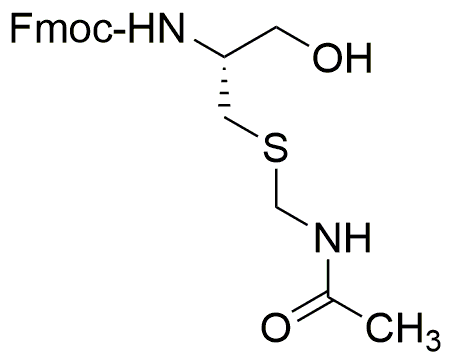Fmoc-S-acetamidomethyl-L-cysteinol is widely utilized in research focused on:
- Peptide Synthesis: This compound serves as a protecting group in the synthesis of peptides, allowing for selective reactions without interfering with other functional groups.
- Drug Development: It plays a crucial role in the design of novel pharmaceuticals, particularly in creating compounds that target specific biological pathways.
- Bioconjugation: Researchers use it to attach biomolecules, such as proteins or antibodies, to other molecules, enhancing the efficacy of therapeutic agents.
- Analytical Chemistry: The compound is employed in various analytical techniques, aiding in the identification and quantification of complex mixtures.
- Biotechnology: It is essential in the development of biosensors and other biotechnological applications, improving sensitivity and specificity in detection methods.
General Information
Properties
Safety and Regulations
Applications
Fmoc-S-acetamidomethyl-L-cysteinol is widely utilized in research focused on:
- Peptide Synthesis: This compound serves as a protecting group in the synthesis of peptides, allowing for selective reactions without interfering with other functional groups.
- Drug Development: It plays a crucial role in the design of novel pharmaceuticals, particularly in creating compounds that target specific biological pathways.
- Bioconjugation: Researchers use it to attach biomolecules, such as proteins or antibodies, to other molecules, enhancing the efficacy of therapeutic agents.
- Analytical Chemistry: The compound is employed in various analytical techniques, aiding in the identification and quantification of complex mixtures.
- Biotechnology: It is essential in the development of biosensors and other biotechnological applications, improving sensitivity and specificity in detection methods.
Documents
Safety Data Sheets (SDS)
The SDS provides comprehensive safety information on handling, storage, and disposal of the product.
Product Specification (PS)
The PS provides a comprehensive breakdown of the product’s properties, including chemical composition, physical state, purity, and storage requirements. It also details acceptable quality ranges and the product's intended applications.
Certificates of Analysis (COA)
Search for Certificates of Analysis (COA) by entering the products Lot Number. Lot and Batch Numbers can be found on a product’s label following the words ‘Lot’ or ‘Batch’.
Numéro de catalogue
Numéro de lot/série
Certificates Of Origin (COO)
This COO confirms the country where the product was manufactured, and also details the materials and components used in it and whether it is derived from natural, synthetic, or other specific sources. This certificate may be required for customs, trade, and regulatory compliance.
Numéro de catalogue
Numéro de lot/série
Safety Data Sheets (SDS)
The SDS provides comprehensive safety information on handling, storage, and disposal of the product.
DownloadProduct Specification (PS)
The PS provides a comprehensive breakdown of the product’s properties, including chemical composition, physical state, purity, and storage requirements. It also details acceptable quality ranges and the product's intended applications.
DownloadCertificates of Analysis (COA)
Search for Certificates of Analysis (COA) by entering the products Lot Number. Lot and Batch Numbers can be found on a product’s label following the words ‘Lot’ or ‘Batch’.
Numéro de catalogue
Numéro de lot/série
Certificates Of Origin (COO)
This COO confirms the country where the product was manufactured, and also details the materials and components used in it and whether it is derived from natural, synthetic, or other specific sources. This certificate may be required for customs, trade, and regulatory compliance.


